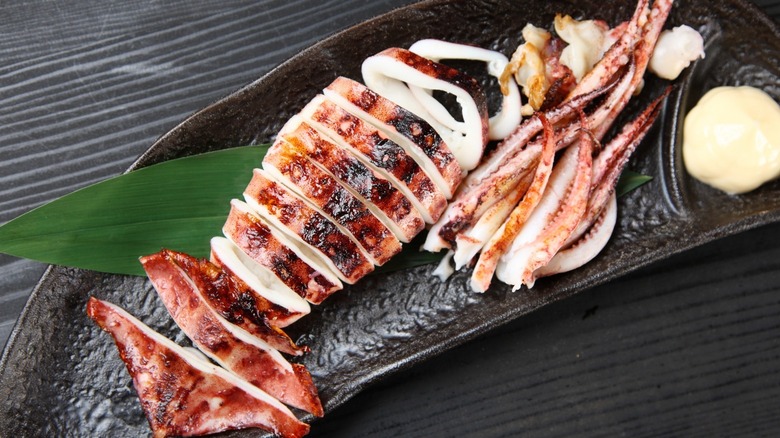Cleaning Squid Isn't For The Faint-Hearted
If you have a hankering for homemade fried calamari, don't let your nerves over cleaning a squid stop you. While squids can seem a bit intimidating to home cooks, they're easier to clean than they first appear. However, this can be a rather messy process, so anyone who is squeamish should probably just order out. To properly clean a squid, you're going to get your hands dirty. In fact, the cleaning process barely calls for a knife.
First things first, we suggest you toss your squid in the refrigerator for at least a couple of hours to mitigate the mess. Letting the squid congeal in the colder temperature will make it easier to clean. There are two main edible parts of the squid — its tentacles and its mantle (the long cone cap on its head). Unlike many other creatures, most of the squid's organs and innards are above its head. So, you're going to want to grab the squid by its head firmly (right where the tenacles connect) and then by its mantle (but not too tightly). Pull the head from the mantle; most of the squid's innards should follow. You may have to squeeze any leftover juices or muck from the now flattened and deflated mantle.
From there, you should remove the cartilage-like bone left behind in the squids' mantle. Some people call it a cuttlebone while others call it a quill. Once removed, feel free to go ahead and deskin-slash-remove any fins from the outside of the mantle.
Tentacles and ink
Moving on to the rest of the squid, you will find the squid's beak or mouth underneath its head. This should be removed and can be plucked out with your fingers and discarded. From there, slice off the tentacles from the bottom of the head and move them over to the mantle. These are all the edible pieces of the squid, but depending on the size of your squid, it may have one last culinary treasure to offer. We're talking squid ink, of course.
Removing the ink sac without busting it may require some precision on your part. There are actually two ink sacs in the squid — a larger one located in the squid's innards and a smaller one behind its eyes. The first should be fairly easy to find. Just look for a small silvery sac and carefully detach it using a knife. From there, you can deposit it into a small bowl to use as an ingredient. However, be warned that squid ink can stain, so your container should be non-porous. The second deposit behind the squid's eyes should be visible after you remove the tentacles. Take a knife to carefully collect the ink. There are foods you can make with squid ink.
Now, that you've cleaned the squid, you can discard its head and innards. However, if you fish and want to avoid waste, you could always chop up the remainder and toss it in the fridge to use later as bait or chum.

